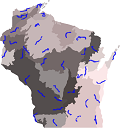
Wisconsin's Standardized Acoustic Driving Transects
Since 2007, Wisconsin acoustic volunteers have monitored statewide bat populations by recording echolocation calls of bats while walking, biking, boating... and now by driving. It is widely accepted that ultrasonic detectors are a cost effective method for monitoring multiple bat species at large spatial scales, especially in white-nose syndrome infected areas where bat populations are low and not evenly dispersed. Besides the walking and water transects volunteers are well accustomed to, the WI Bat Program is now incorporating Driving surveys into its survey regimen. Conducting driving surveys will help WI provide data on a national level that ensures efficiency and consistency of efforts.
Below are instructions for conducting acoustic driving surveys and how to sign up for routes. Each route is driven and surveyed 3 times per year starting on June 1st.
Read about previous years' efforts in the yearly Driving Survey Summaries.


This site is produced in conjunction with the Wisconsin Aquatic and Terrestrial Resources Inventory and sponsored by the Wisconsin Department of Natural Resources. The information presented on this site is subject to the Wisconsin Department of Natural Resources' Legal Notices, Disclaimers, and Terms of Use.

